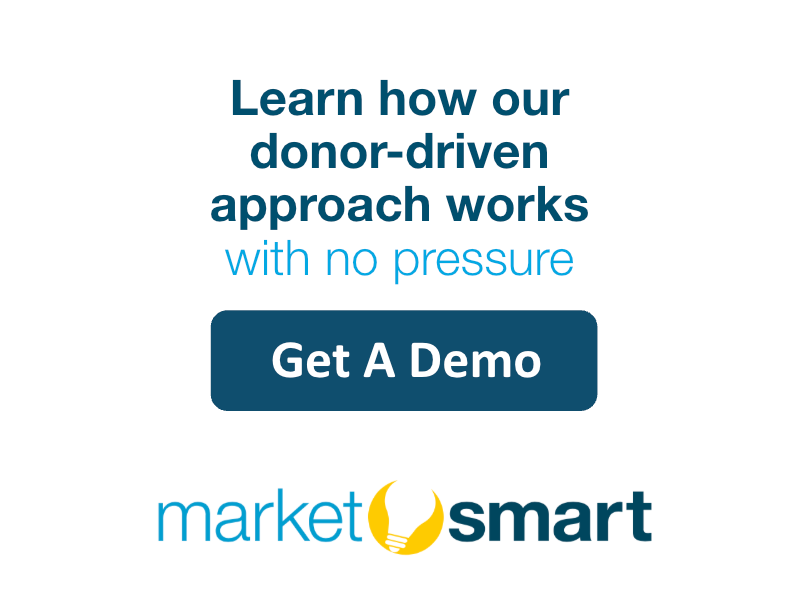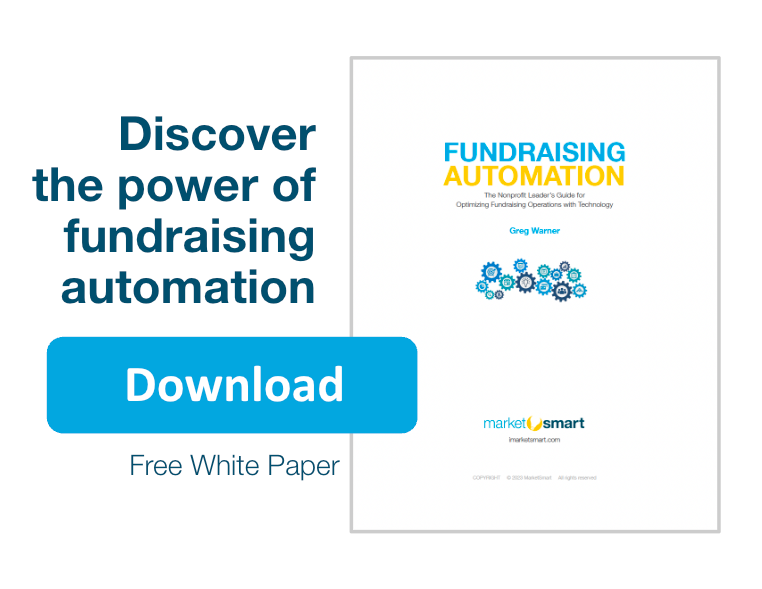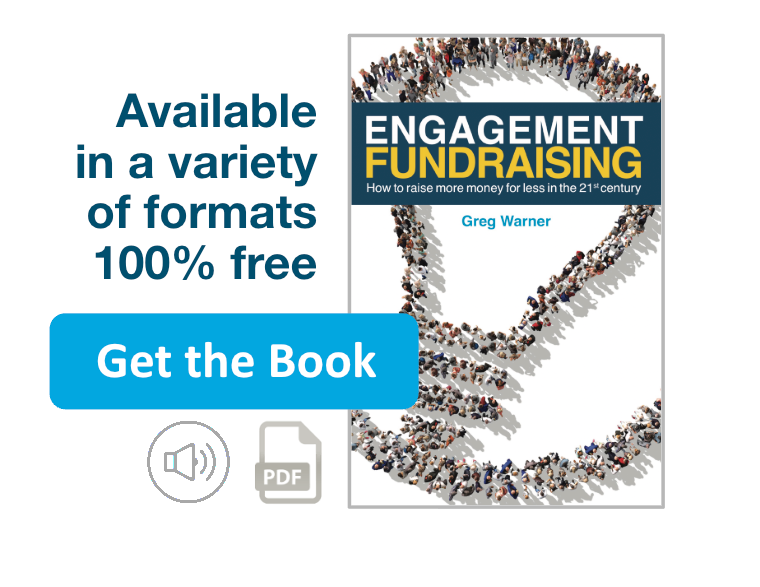Prospect research, RFM, wealth screeners, and other hands-off/arm’s-length methods of donor discovery can only work so well. And more often than not, the people they identify turn out to not be viable candidates for major gifts.
In fact, we’ve written about five popular donor discovery methods that fail more than they succeed, and leave gaping holes in your organization’s fundraising that gift officers must struggle to fill.
There is a better way.
The best strategies for donor discovery are about engagement. The way to know if a person is interested in your mission is to give them opportunities to raise their hand and involve themselves with your organization in some way.
And when you use digital engagement strategies rather than relying on overworked gift officers and unreliable prospect research strategies, you quickly realize that you can conduct donor discovery for low cost and on a large scale.
You can identify far more good major donor prospects from your database using this approach – people the screeners and machine learning bots will overlook.
31 Donor Discovery Strategies that Work
We know these donor discovery strategies work, because we use them in our software system that nonprofits like yours sign up for. And our clients are very happy with the results.
In fact, our approach works so well at identifying major donors that we offer a 10:1 ROI Guarantee to new clients. You will make at least ten times more in pledges and gifts than you will spend on our software. We can only offer this guarantee because we have seen our system work so well over and over again.
To be clear, the 31 strategies you’re about to see are not all digital in nature, but we use digital engagement to present them to supporters. They hear about these offers digitally, and they respond digitally. That way, with automation, none of your people have to do any of the work at this stage.
Why Do These Strategies Work?
These donor discovery strategies work because they deliver value. They offer attractive and engaging experiences and opportunities that mean something to the people who request them and participate. Otherwise, they wouldn’t request them or participate.
People who respond to value-driven offers are people who have at least some interest in what that offer represents.
Delivering value that engages people is a far better approach than just smacking them with appeal after appeal after appeal, hoping that eventually they’ll lower their head and respond.
So, let’s take a brief look at these 31 donor discovery methods.
Surveys
Surveys are simple but massively effective when done well. You can learn so much about supporters that gift officers can follow up on later, like their values, past history with your organization, influential people in their lives, motivations for giving, wealth capacity, and so much more. See 6 reasons why donor surveys work.
However, be careful with this tool. We’ve analyzed data among organizations conducting surveys with and without follow-up cultivation and found that the ones that survey donors and fail to follow-up actually lose those supporters. Why? Because they feel unheard. That depletes trust and drives defection.
If you don’t truly care about what your supporters say, don’t survey them.
And if you do care, be sure to follow-up with every single survey respondent regularly to prove that you heard and understand them.
Quizzes
Quizzes are more fun than surveys, and you can use them to inform and educate in a format that’s enjoyable and interactive. The best kinds of quizzes give some kind of score at the end that gives the donor some sort of evaluation. For example, “You got 9 out of 10 questions right. You’re ready to join the fight!” Or, for someone with a lower score, “You got 3 out of 10 questions right. Want to learn more? Read this success story!”
Invitations to join a board or committee
Certain types of people like to get involved in this way, and it may surprise you sometimes who those people turn out to be. And this is why surveys are at the top of this list. Surveys can confirm the sorts of offers you should make to particular supporters as you continue to digitally interact with them.
For example, you can include a survey question that asks if the supporter has any interest or curiosity about serving on a committee one day. Then, for those who answer positively, you can send an invitation sometime later.
Games
Games can accomplish similar outcomes as quizzes, just using a different format. You can get creative here with different game types. Examples include trivia games, games where you guess the true numbers of real-world statistics that relate to your mission, and scavenger hunts either online or in person somewhere.
Polls
Polls are a type of survey, but much lighter, and usually just a single question.
ASPCA has a great campaign they’ve run a few times where they send pictures of a new kitten and ask people to send in names. Then, everyone gets to vote on their favorite from the top four names. It’s a simple engagement strategy that lets them know who is active and interested in what they do.
Videos
You can make videos about all sorts of things, such as:
- New program launches
- New initiatives
- Updates from the field
- Volunteer testimonials
- Immediate needs
- Inspirational stories
What you don’t want to do is make videos that just tell how great your nonprofit is. That sort of generic fluff won’t be appreciated, and is not valuable to supporters.
Create stuff supporters would want to see and hear about. Then, send out access to the videos via email.
Advocacy or activism opportunities
Every organization will have its own version of how this looks. If you’re a national organization, push opportunities that are local if you have location information about your supporters. And you can also run national campaigns such as initiatives to contact a congressperson.
Podcasts
For people who value podcasts, these have the same appeal as videos, but they allow for more depth because lots of people listen to podcasts while they’re doing other things like driving, cooking, or working out.
This is a great place to do in-depth interviews, and explore the more complex aspects of an issue that can’t be adequately dealt with in a blog or a short video.
Testimonials and stories
If you can’t get video testimonials, you can definitely produce written ones. Offer these up via email, and the people who want to see the impact their donations will have will jump at the chance to read them.
And remember – not all stories need to have happy endings. As long as you tell it in respectful ways, disappointing endings can work too, because they demonstrate the ongoing need.
The other type of ending is the unresolved ending. And this can work well too, because to make that story end well will take ongoing support.
To be clear, our point here isn’t necessarily to ask for donations along with the testimonials. Whether you ask or not, good stories will produce the desire to help for people who may one day become major donors. It’s a natural effect on the donors you are trying to discover.
Testimonials also can feature donors, supporters, volunteers, and even employees – why they care, how they got involved, and the difference it has made.
Webinars
Webinars function much like videos and podcasts, but it’s a different medium. People will generally sit for more time to watch a webinar than a video, so you can get away with an hour in length for these. So this again gives you more opportunity to go deeper.
Streaming live events
If you have any sort of live event, you can offer the option to stream it for supporters who aren’t local or who can’t attend. Anyone who raises their hand and wants to participate in an event they can’t attend is a great candidate for becoming an ongoing supporter and possibly a major donor.
Q&A sessions
This often comes at the end of a webinar, but you can do an entire production that is just Q&A. If your organization is dealing with a difficult challenge, or something came up in the news that has people asking questions, or you’re launching something new and want people to buy in to it, a Q&A session can be a great incentive to engage for people who want to be more involved in your mission.
Opportunities for supporters to tell their story
This is another great way to discover potential donors. Here, you give them the chance to share why they care so much about your mission. The great thing about this is, not only will the simple act of sharing their story bond them with your nonprofit, but then you get to share their story with others.
MarketSmart has perfected this approach with their Tell Your Story add-on feature. If you’d like to see how that works, be sure to contact us.
Reports or eBooks
eBooks are yet another way to share stories of impact and success, when those stories involve more detail than can be fit into a short letter or email. You can also create eBooks about particular issues or problems, and for signature narratives you will use for many years.
Likewise, you can create reports to unpack the challenges related to a particular issue. People who care about that issue will raise their hands and ask for the report.
Workbooks
This is a more interactive way to get people engaged with the work your nonprofit does. It’s like a report, but requires the reader to become a participant. In fact, you can easily turn an eBook, webinar, podcast, or report into a workbook. Just write questions and place them throughout the text, and you’ve got a workbook.
Blogs – with comments enabled
Blogs are one of the easiest ways to engage your supporters, but hardly any nonprofits use them. Offer articles to your supporters via email, and enable comments so they can share their reactions and opinions.
Again – you do this for the purpose of donor discovery. Almost anyone who clicks to read a blog has some interest in your mission. And almost anyone who leaves a positive comment certainly does. You can then advance them to a higher level of engagement.
Sharing tools
This is about the lowest level of engagement out there, and it’s super easy. Whatever content you put out, include social media sharing buttons, and make sure they work!
Your goal here isn’t just for people to share your content, though that’s great. More important is the person who shares it – that person is advocating on your behalf. An advocate is already a great candidate for donations, and could become a major donor too.
Matching campaigns
Lots of people donate one-time gifts. But people who donate to matching campaigns demonstrate a higher level of concern about your mission. They really want to help, and see this for the great opportunity that it is. Keep track of your matching campaign donors.
Sponsorship opportunities
Not every nonprofit can do this, but many can do it in some form. And you don’t just have to offer sponsorships like ‘sponsor a child.’ This also includes event sponsorships for business allies. The business owner who chooses to ally with your organization clearly cares about your mission. They too are a potential major donor.
Scholarships
If you offer the chance to fund scholarships, anyone who takes you up on that cares about the impact of their money. They want to make a tangible difference in someone’s life. If they also have great wealth capacity – or will acquire it later in life – this is a major donor in waiting.
Naming opportunities
You don’t just have to let wealthy people have buildings and scholarships named after them. You can also offer smaller opportunities to be named, like on bricks or tiles of a new building, or a plaque featuring all donors to a campaign, or on the boards of a fence around a new playground.
If you get creative, you can come up with naming opportunities for all sorts of things. Anyone who responds to that is someone who cares about their legacy. And that is a potential major donor.
Contests
P2P fundraising is an example of a contest. Anyone who tries to win this sort of contest is motivated to make a difference with respect to your mission. You can also run simpler contests at live events and over email.
For example, have everyone send in a silly holiday picture for some holiday, and the winner gets to meet the president, or tour a facility, or meet a beneficiary, or some other prize that would be desirable to someone who wants to be involved in your mission.
You can also do things like baking contests (mostly for local organizations).
Group activities
Work parties are a great way to get people involved and see who likes to show up and achieve something practical. This is a special type of volunteer activity, because it values the group as much as the work itself.
Events
This includes live fundraising events, as well as golf tournaments, 5k races, and concerts. The idea with all of these is, whoever shows up cares about your mission to enough of a degree to be there. Get their information. Follow up. The event is just one time. But you can find future volunteers, supporters, and potential major donors through these events.
Ask for advice or critiques
Some people love to share their advice and give their opinion about things that matter. If your organization is struggling in some way, maybe open up the opportunity for people to give their ‘two cents.’ Whether you end up taking the advice or not (though you need to consider it and respond either way), the secondary benefit of this is that you now have a list of people who care enough about your mission to share their thoughts about something you need help with.
That sort of person, with wealth capacity, is a potential major donor.
Maps
For organizations that work in the natural world, sharing maps of places relevant to your supporters can be greatly appreciated. You might share a map of hiking trails, or campgrounds, or rivers or lakes people can visit and enjoy.
Colleges can also send maps of their campuses, which can be very large, and highlight certain places. And nonprofits that operate in other countries can send maps of where they work in those nations.
Anyone who asks to see a map like these must have some degree of interest in your work. It’s a simple and very low-bar strategy for potential supporters to raise their hand and engage with you.
Tours and show-and-tell sessions
People like to see behind the curtain. Let them walk through and see the facility, meet the staff, and see how the magic happens. Only interested people will take you up on an offer like this. And as always, don’t let them get away before you log their engagement so you can build on it from there.
Presentations of scientific research
For the brainy types of potential supporters, and for organizations that can do this, share research findings that are relevant to your mission. You can do this via webinar, podcast, video, written report, or in-person. Or – you can do ALL of those.
Do a live seminar. Record it with video and audio. Transcribe it. And you now have a multimedia donor discovery asset.
Mentoring opportunities
Some people who care about a cause really want to make a direct impact. Some organizations can offer mentoring opportunities for their supporters to help someone in need. If you can do this, it’s a great way to identify supporters and potential major donors.
One-to-one interactions with beneficiaries
This isn’t mentoring so much as just meeting them. It could mean going out to lunch with the beneficiary and someone from the organization. Or getting to be part of an experience the beneficiary is going through with the organization.
Personal interaction with someone who directly benefits from financial support will make a lasting impression on a supporter who is a potential major donor. This could become one of those transformational experiences that changes the course of the supporter’s life. You never know. And that’s why you offer these experiences.
Volunteer opportunities
This is more general, but the goal is the same. Get people involved. Many volunteers become donors. Many wealthy people volunteer. Therefore, there’s a good chance you have potential major donors among your volunteers.
How Digital Engagement Can Use These Strategies
If this seems like it will be a lot of work for you – it doesn’t have to be.
MarketSmart’s digital engagement software automation was built to achieve what you’ve just read about. Our system automatically sends out emails with valuable donor discovery offers like these, and we track who engages. Over time, new major donor prospects emerge that you never would have found any other way.
It works. Really really well.
If you’d like to see how it works, you can schedule a free demo here.
Related Resources:
- How Many Major Donors Are You Overlooking Right Under Your Nose?
- The Secret to Raise Money More Cost-Effectively: Stop Fundraising
- 4 Primal Motives for Major Gifts – the REAL Reasons People Make Transformational Gifts
- 10 Questions You Should Ask Your Wealthy Supporters to Motivate them to Give




